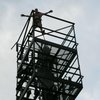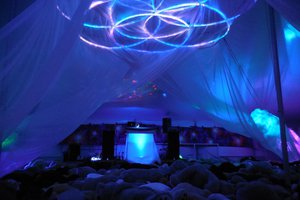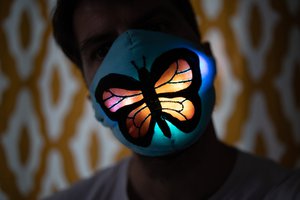Special thanks to Utah Opera, the staff at the Capitol Theatre, and the wonderful members of IATSE local 99 for helping to realize this production.
Arduino Sketch: https://github.com/ld3300/2023_LaBohemeFireEffect
Due to the other work needing to be done for the show, and the proximity to opening night, it was a quick and dirty build. From the LED tape found in the opera company work kit I chose to utilized just the warm white, red, and green colors. Serial commands were enabled to live test different variables that I would then do a quick hard code of and re-upload. There wasn't time to write and get functional a command to save to persistent storage.
The intensity and timing values were chosen randomly on each cycle. There are timing variables that, with the constrain() function, can bias the timing towards longer or shorter.
The green LED was included to work with the red LED to provide a more light amber. There isn't really red in the light that comes from a fire, so the red and green were to provide intensity and a little variability in color temperature.
The final value for the green LED is constrained to a chosen percentage of the red LED. The value chosen was enough to keep the red from becoming prominent, while preventing any instances of green overpowering the red.
The tape in the garbage can ended up causing too much illumination through the side holes in the can compared to the light emanating from the top. Tested a diffusing concept with a couple of sheets of printer paper, and it worked so well I used it as the final circular diffuser in which the tape was placed. After making the tape circle put hot glue around the top and bottom to add rigidity so the cylinder couldn't collapse.
The Utah Opera Head Carpenter modeling the effect during quick test:
A snippet of the effect during dress rehearsal. Cell phone video taken by myself.
La bohème produced by Utah Opera at the Capitol Theatre in Salt Lake City, UT. Directed by Garnett Bruce, Maestro: Robert Tweten, Stage Manager: Peter Nictakis, Scenic Design: Peter Dean Beck, Lighting Design: Jim Sale, Costume Director: Carol Wood, Properties Master: Kelly Nickle, Technical Director: Sam Miller, Production Master Electrician: David O. Smith.
 David O. Smith
David O. Smith





 Josh Cole
Josh Cole
 richardginus
richardginus
 Stephen Tranovich
Stephen Tranovich
 Sander van de Bor
Sander van de Bor
Man, those backstage photos really take me back. Glad to see little has changed in nearly 40 years...
I wrote this up for the blog, should hit the site soon. I had a little fun with the title, hope you don't mind -- it's with love of the craft. Great work, thanks for sharing!